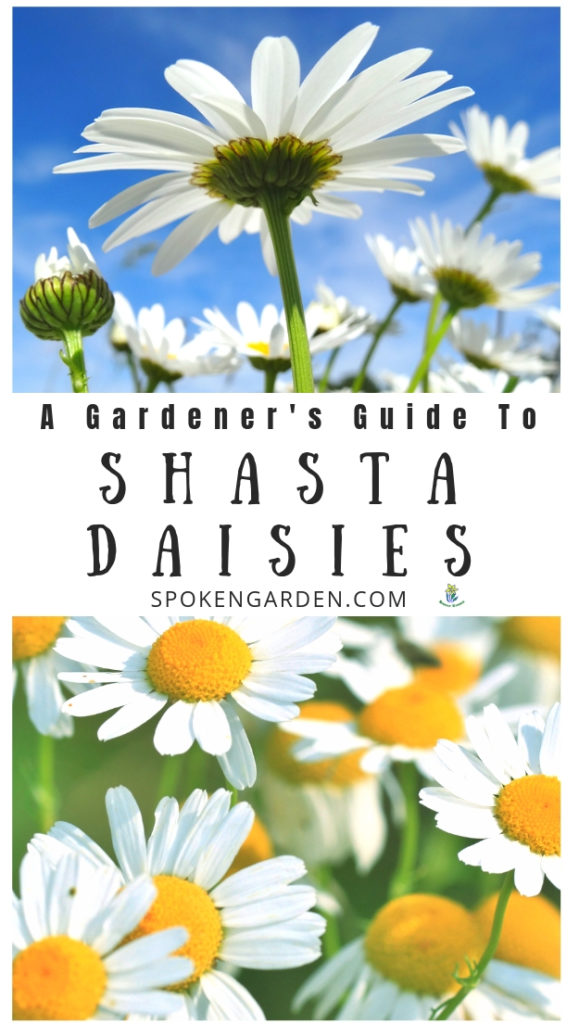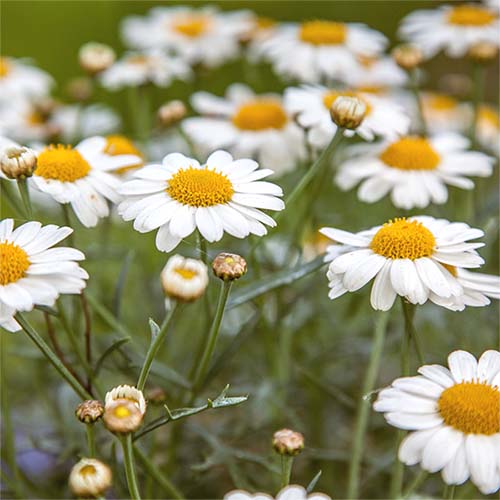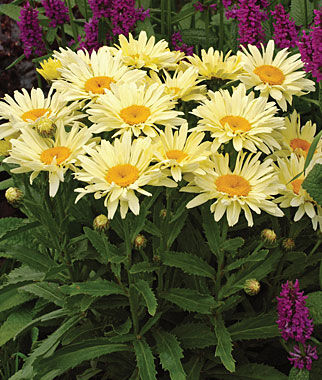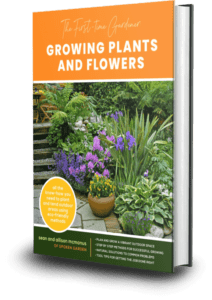Learn all about your beautiful, summer-blooming Shasta daisy plants in this gardener’s guide.
A perennial summer favorite, these cottage garden flowers will bloom profusely throughout most of the summer, attract tons of pollinators, and require very little maintenance.
And, they have quite an interesting history which we’ll tell you about below.
Shasta Daisy Quick Profile
| Sun Exposure | Full sun, with some partial shade in hotter climates . |
| Water Needs | Regular/Moderate |
| Soil Needs | Well-drained, enriched soil. |
| Cold-Hardiness Zones | USDA hardiness zones 4 to 10. |
| Bloom Time | Beginning to late-Summer. |
| Flower Colors | White with yellow center. |
| Mature Height/Width | 2 – 4 feet tall and 2 feet wide. |
| Plant Spacing | 0.5-1 foot between each Daisy and other plants. |
If you are looking for Summer Flowering Bulbs to add to your garden, look no further than our ebook
21 Spring-Planted Bulbs For Fantastic Summer Color!
It’s has 60+ pages of summer flowering bulb inspiration and you can get to know the different plant care needs of these 21 gorgeous spring-
planted, summer-flowering bulbs. Whether you are already familiar with bulbs or are just learning about them, this guide explains what bulbs are, defines the 5 different types of bulbs, the correct planting orientation for each of the 5, and much more.
You also get to know each of these 21 spring-planted, summer-flowering bulbs intimately for their care needs like where they will grow, when they flower, different flower colors they are available in, and which online-retailers you can buy your very own to then add to your garden.
Grab your copy now and start planning your spring and summer flower garden TODAY!
In our Shasta daisy guide below, you’ll learn what sets these daisies apart from their numerous family members. For a quick podcast version of this post, check out Shasta Daisy Care here.
To prolong the life of your Shasta daisies throughout the summer months (maybe even into the fall), you need to deadhead them at the right time using the proper tools (see below for when to do this).
This pruning and deadheading tool is perfect to keep them and other plants continuously blooming. Oh, and make sure to have your watering wand a watering can, along with all your other watering gear, ready for this coming garden season.
Also, if your flower stems are really tall, here are green wood stakes to keep them propped the whole season.
Read our Shasta daisy plant post below to learn:
How to grow and care for daisies in your yard
- Shasta daisies for sale
- How to divide Shasta daisies
- Different Daisy Flowering Plants
What to know about the Shasta Daisy
First, what’s not to love about these gorgeous, white flowers? They are so cheerful and fun! While evoking a sense of happiness just from their presence alone, they also enhance the garden and provide a beautiful accent to borders.
Plus, they make great cut flowers.
In addition to their beauty, these hardy perennials are really easy to maintain.
With just a bit of deadheading for spent flowers, the Shasta daisy can be enjoyed throughout most of the summer months. For that reason, they are perfect for a beginner gardener. However, these versatile plants can also challenge a novice gardener if the need arises to divide them, perform pest control methods, or otherwise engage in more taxonomy of the family group.
Also, Shasta daisies are ideal for busy “weekend warrior” gardeners, like we are, who are super busy during the regular work week but also want to enjoy a beautiful, healthy garden.
Finally, the Shasta daisy is a pollinators’ paradise. All kinds of bees, butterflies, and other insects (ever heard of a pollen beetle?) will flock to the large, robust flowers to feast. Enough said.
By the way, our plant information below is meant for beginner gardeners but can be used by anyone who wants to learn more about this plant. We hope it’s helpful for you!
Shasta Daisy Flowers: Family and History
Daisy Family
Shasta daisies are in the family Asteraceae (Compositae). Also known as the Daisy Family, this family group has more than 20,000 species of flowering plants throughout the world!
The daisy family features unique flowers that are actually made up of two types of flowers, not just one. Each flower you see in this family is actually composed of one or more rows of “ray” flowers on the perimeter/edge and the “disk” flowers in the center.
Overall, this plant family is very important economically as they’re known for their cut flower value, cooking oils, herbal teas, etc. Some daisies are used medicinally while others are considered invasive.
Family members include sunflowers, zinnias, lettuce, and chrysanthemums to name a few.
Shasta Daisy History
First and foremost, Shasta daisies have gone through some botanical name changes in the recent past.
They were categorized in the Chrysanthemum genus but were later recategorized into the Leucanthemum genus. Today you might see either name refer to the Shasta Daisy in books or even online. It can get a little confusing especially since not everyone agrees with the genus name change.
Throughout history, daisies have symbolized innocence and purity.
The name “daisy” comes from the term “day’s eye.” It refers to the fact that the daisy flowers close up at night and then re-open in the morning.
The Shasta daisy was created in 1901 by an American botanist named Luther Burbank at his experimental farm in California (more on him below). A famous plant cross-breeder, Burbank desired to create a snow-white daisy. He bred multiple daisies together to create this masterpiece, including the oxeye daisy and three other varieties.
Finally, after 17 years he succeeded in creating the famous, iconic daisy we know today, the “Shasta daisy,” which was named for the “snow white” peaks of Mount Shasta in California.
Luther Burbank and Burpee
In addition to the Shasta daisy, Luther Burbank bred and created some other plants you might be familiar with, the most famous being the Russet-Burbank Potato.
Today this hybrid is more commonly known as the Russet Potato! One of the most popular potatoes in the world!
Luther Burbank was a distant cousin of W. Atlee Burpee of the Burpee Seed Company. Upon Burbank’s death, rights to several of his creations were eventually acquired and sold to Burpee, including these daisies.
Of course, Burpee seed company is still thriving today and they have great flowers, seeds, and other products to choose from!
In fact, if you want to place an order for your own Shasta daisies, try these varieties below. Just click on the pictures you like and buy them now. Who knows, you could be purchasing a daisy cultivar that was originally created by Luther Burbank!
Here’s a Shasta daisy currently offered by Burpee:
Different Daisy Flowering Plants
There are so many different types of daisies out there in addition to Shasta daisies.
They differ by flower form, size, bloom time, and stem length.
And of course, there are many different colors to choose from.
- Shasta Daisy
- Creeping Daisy
- Painted Daisy
- African Daisy
- English Daisy
- Ox-Eye Daisy
- Gerbera Daisy
- Montauk Daisy
- Marguerite Daisy
- Purple Coneflower
- Aster
The list goes on and on!
Shasta Daisy Videos
Dividing Perennials
Dividing your Shasta daisy plants is a great way to fill in and expand your own garden and also share gifts with other gardeners.
Dividing a perennial plant, like Shasta daisies, usually happens in the fall months because most garden plants are done flowering and are starting their dormancy process to survive the upcoming cold, winter weather.
In order to divide your plants successfully, follow these steps:
- Assess the health of the plant (See below for more on that)
- Use a shovel to cut away a portion of the plant’s crown into 2 (or 3) pieces.
- Make sure you have roots in each new segment
- Remove the new portion
- Clear away the area where you want to transplant your new segment
- Re-plant into a new location.
- The cut piece needs to be re-planted right away.
Assessing the Plant’s Health
Only a plant that is deemed healthy enough should be divided.
In general, you can divide a plant if:
- It looks healthy with no major trauma
- It has been growing in its garden location for at least two years (usually longer)
- It is starting to get too big for its current location and is growing into other plants.
Shasta Daisies For Sale
Now it’s time to pick out your own shasta daisy seeds from Eden Brothers or live plants from Burpee!
You have to see these beautiful options!
Shasta Daisy Seeds
This season, we’re planting the Daisy Crazy seed mix from Eden Brothers which includes 10 species of different daisies. Some are annuals and some are perennials.
Here are a few of the types of daisies included in the mix:
- Shasta Daisy
- Creeping Daisy
- Painted Daisy
- African Daisy
- English Daisy
- Ox-Eye Daisy
Already, we’re impressed with how fast our large order came in the mail. Plus we got a free gift!
Shasta Daisy Seeds from Burpee
Below, we have options for more daisy seeds from Burpee if you want to add these to your garden.
Each of these pictures below is a clickable link:
- Crazy Daisy
- Snow Lady
Shasta Daisy Plant Conclusion
Even with its interesting history and complicated, diverse family group, the Shasta daisy remains simple and pure.
Perfect for either the beginner or busy gardener, Shasta daisies are uncomplicated.
While not asking for much, they are a low-maintenance, beautiful addition to any garden.
Now it is time to hear from you!
What do you love most about daisies?
Leave a quick comment below and let us know!
Well, that’s all for now.
Want to learn about other plants in your garden? Check out some of our previous plant profiles:
- The Captivating Crocosmia
- The Fantastic Fuchsia
- The Curious Calla Lily: April Plant Profile
- A Rose By Any Other Name: February Plant Profile
- The Divine Daffodil: March Plant Profile
See you in the garden!
~ Sean and Allison
P.S. Follow us on Pinterest, Twitter, Facebook, and Instagram so you don’t miss a thing!
Shasta References Used:
- “Shasta Daisy” – Better Homes & Gardens
- “Luther Burbank” – Luther Burbank Homes and Gardens
- “Types of Daisies” – HGTV

Click the graphic above to save “Shasta Daisy Plant Profile” to Pinterest for later!




